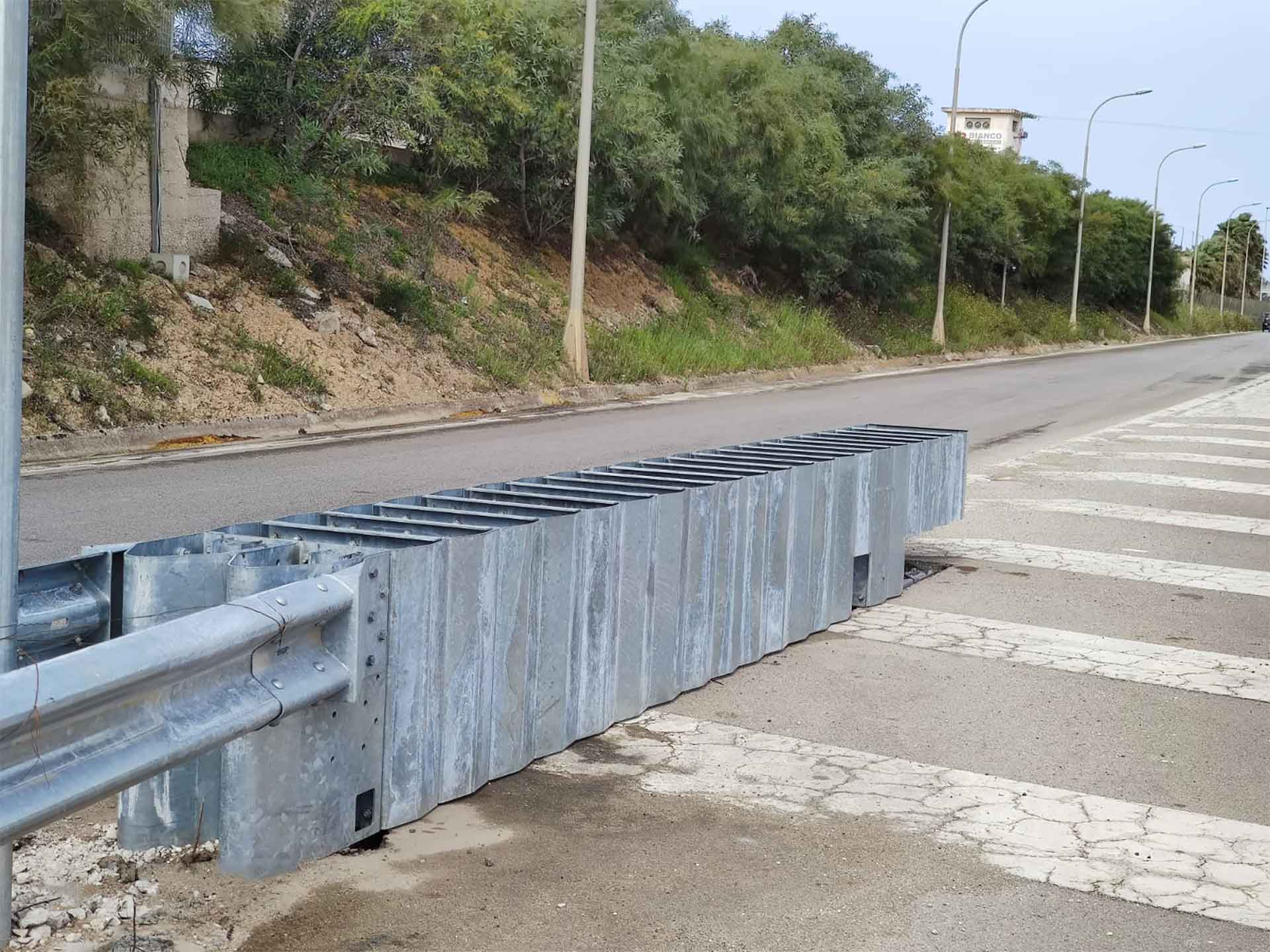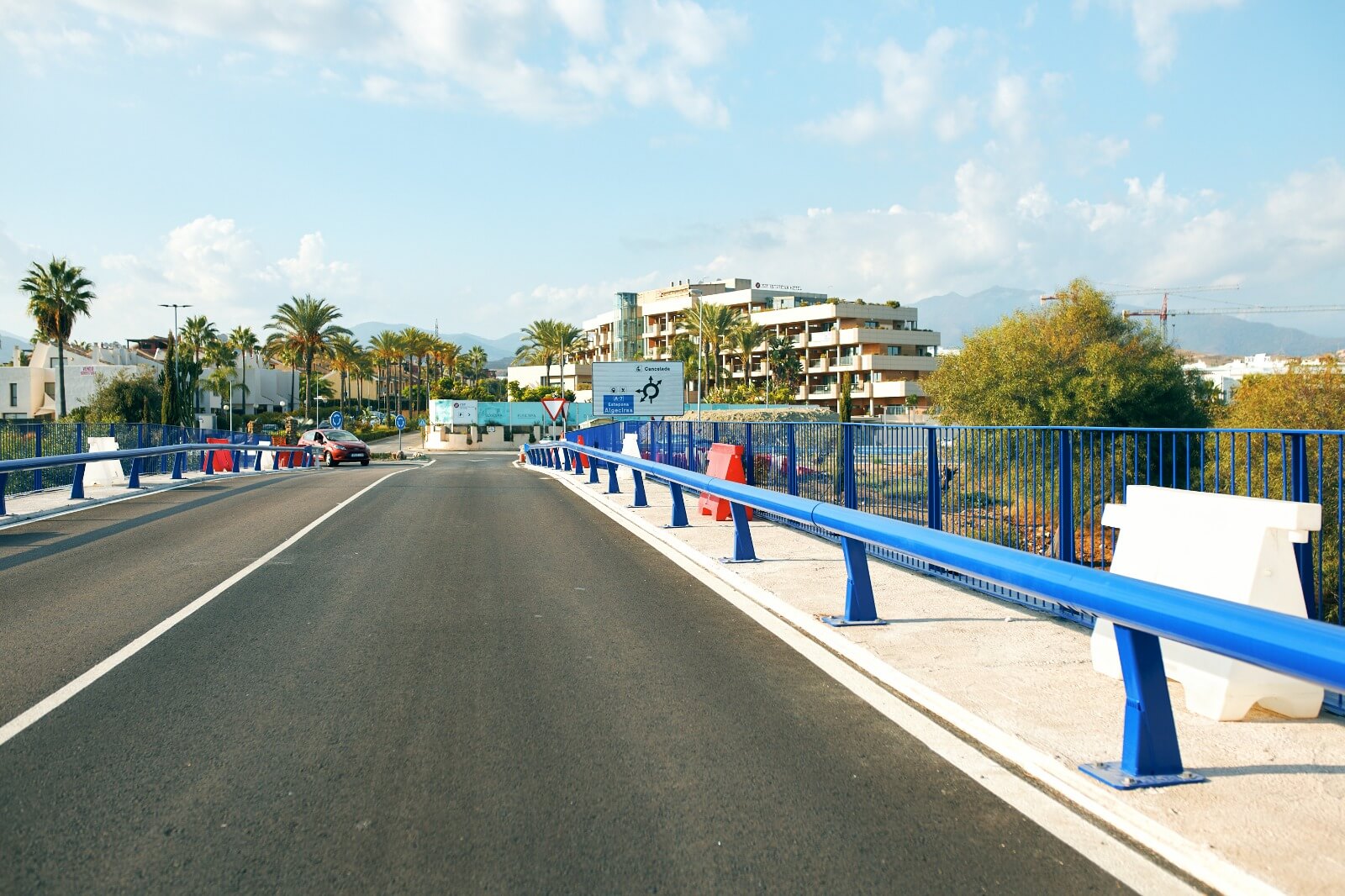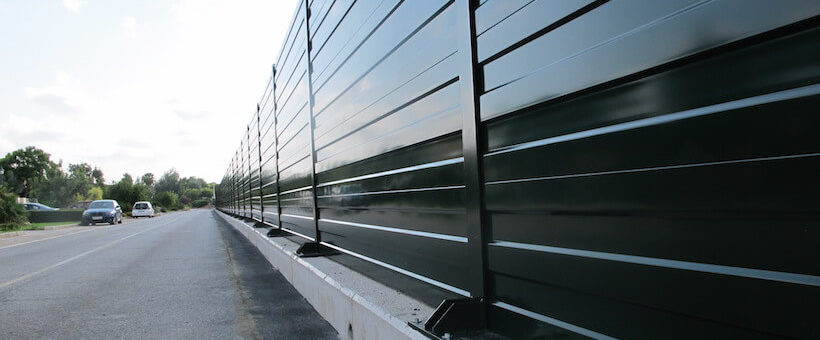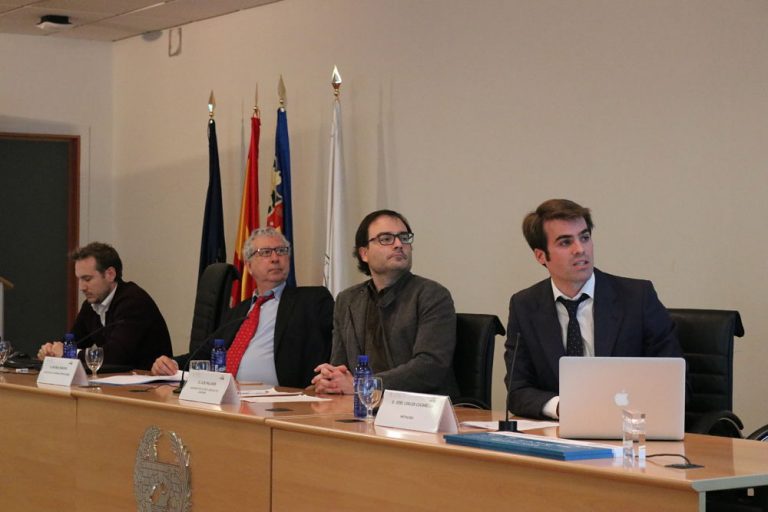Eco-goals: our sustainable contribution
Welcome to the heart of Metalesa, where sustainability is not just a goal, it is our unwavering commitment! In this article, we will look at the Eco-Targets, the four pillars that guide our mission to be leaders in environmental and social responsibility.
Solar panels: clean energy for a sustainable future
Every action counts, and at Metalesa, we are committed to significant change through solar energy. Our facilities are equipped with solar panels that capture sunlight and transform it into clean electricity. This step towards energy self-sufficiency not only reduces our carbon footprint, but also propels us towards a more sustainable tomorrow.
Did you know that thanks to our solar panels, we have covered 39.6% of our consumption needs and reduced our dependence on non-renewable sources? This investment in green technology is a testament to our commitment to the environment.
Additional benefits of solar panels
Exploring the use of solar panels goes beyond simply adopting a clean energy source; it involves immersing oneself in a series of impactful benefits that impact various aspects of our society and environment. Let's take a closer look at these additional benefits, understanding how solar panels are a comprehensive solution with significant positive impacts:
- Reducing greenhouse gas emissions: By going solar, we make a significant contribution to reducing greenhouse gas emissions, a crucial factor in climate change. Solar panels generate electricity without releasing carbon dioxide or other harmful air pollutants. This approach offers a route to a cleaner and more sustainable environment, making a direct contribution to the fight against climate change.
- Energy independence and long-term stability: Dependence on non-renewable energy sources exposes societies to fluctuating oil prices and energy crises. By incorporating solar panels, greater energy independence is achieved by harnessing an inexhaustible and free source: solar radiation. This independence not only ensures long-term stability in energy supply, but also reduces vulnerability to fluctuations in the global energy market, providing a path to long-term sustainability.
- Contribution to global awareness of renewable energy: By adopting solar energy technologies, we actively participate in creating global awareness of the importance of renewable energy sources. Solar panels are not only a practical solution on an individual or corporate level, but also serve as a beacon to inspire others to follow the path of sustainability. This contribution goes beyond the production of electricity, extending to the creation of a global community committed to a greener and healthier future.
Using recyclable materials: forging a circular future
At Metalesa, the excellence of our products is not only about quality, but also about environmental responsibility. In the manufacture of every item, we are committed to using recyclable materials, thus driving the creation of a circular future and significantly minimising our impact on the environment.
This conscious choice means much more than just producing durable goods. By opting for Metalesa products, you are making a decision to support solutions that go beyond your individual needs; you are supporting the preservation of our planet. Our unwavering dedication to recycling is not simply a duty we fulfil, it is a promise we seal with every product that leaves our facility.
Imagine a world where every product not only serves its purpose, but also contributes to a sustainable cycle. At Metalesa, we're not just building products, we're building a future where responsibility and quality are intertwined to form a lasting commitment to the health of our planet.
Sustainable innovation in our commercial fleet: towards electrification
At Metalesa, we strive to not only deliver quality products, but to do so in a sustainable manner. Have you ever wondered how we achieve this balance? The answer lies in our commercial fleet, a tangible manifestation of our commitment to electrification and the reduction of pollutant gas emissions.
Our fleet, your benefits:
We explore the salient details that make our fleet a model of sustainability:
- Hybrid vehicles: By opting for electrification, we have incorporated hybrid vehicles into our fleet. These vehicles not only consume less fuel, but also emit less polluting gases, marking a firm step towards reducing our carbon footprint. Every delivery we make becomes a conscious act towards a healthier environment.
- Advanced technology: We don't stop at electrification; we have integrated advanced technology into our fleet to maximise efficiency. Real-time tracking of our routes ensures that every journey is planned as efficiently as possible, reducing unnecessary driving times and further minimising our environmental impact.
- Constant innovation: Innovation is part of our identity. We constantly explore options to improve our fleet and thus our contribution to sustainability. From evaluating new technologies to sourcing alternative fuels, we are in a continuous search for greener and more efficient methods for our delivery operations.
Every delivery we make is not just a product arriving at its destination; it is a step towards a more sustainable and environmentally friendly business model. At Metalesa, we are moving towards electrification in the knowledge that every choice counts in building a future where innovation and sustainability go hand in hand.
Zero discharge wastewater treatment plant: taking care of our water resources
Our responsibility is not limited to air and land; we also embrace water. We operate a zero discharge wastewater treatment plant, ensuring that our production processes do not negatively affect the quality of nearby water resources.
How does this contribute to general well-being?
- Water conservation: We avoid contamination of local sources.
- Community engagement: Our responsibility to those around us.
- Transparency: Accessible information about our practices.
Join us on the road to a sustainable future
At Metalesa, every action we take is driven by the desire to contribute to a more sustainable world. Our Eco-Targets are more than just goals; they are the core of our identity and the engine that drives our commitment to sustainability.
Ready to be part of the sustainable revolution? Join us on this journey and choose products that not only meet your expectations, but also contribute to a greener, healthier planet.
Frequently asked questions:
- How do solar panels contribute to sustainability? Solar panels capture the sun's energy and convert it into electricity, reducing dependence on non-renewable sources and reducing greenhouse gas emissions.
- Why is it important to recycle in the manufacture of products? Using recyclable materials in manufacturing helps reduce demand for natural resources and minimises waste generation, thus contributing to building a more sustainable future.
- How can I contribute to zero landfill? As a consumer, you can choose to support companies committed to sustainability and responsible water management, such as Metalesa. By doing so, you indirectly contribute to the goal of zero landfill.
Act today for a more sustainable tomorrow! Explore our product range and choose sustainability in every purchase. Together, we can build a greener, healthier world.
Changes in the regulations on barrier transitions and terminals
When talking about vehicle containment systems, the first thing that comes to mind are safety barriers and parapets. These linear elements are installed on the edges of roads to prevent vehicles from leaving the road and causing serious accidents. Although these are the first that come to mind, there are also other types of vehicle containment systems, such as impact attenuators, transitions between systems, barrier terminals, removable barrier sections and protection systems. of motorcyclists.
All of these systems are regulated by different European regulations that establish the requirements that must be met to be classified in one of the categories contemplated by said regulations. In the case of transitions and barrier terminals, the reference standard is UNE-ENV 1317-4:2002 and in this article we want to talk to you in a little more detail about the changes that are to come.
This standard, which has been in force since April 30, 2002, has never been harmonized by UNE-EN 1317-5:2008+A2:2012. This means that any Transition or Terminal that meets the tests specified in said standard will be accepted, but will not have the CE marking. Therefore, this standard is voluntary and there is no clear impulse on the part of the administrations to require this type of products evaluated under the protection of this standard.
This situation gives rise to points on the State Highway Network that are not well resolved and that can cause serious accidents.
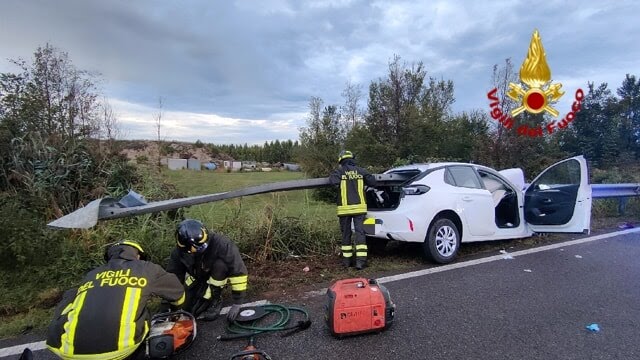
The need to modify this regulation
The European standardization committee “CEN/TC 226/WG 1 – Crash barriers, safety fences, guard rails and bridge parapets” is responsible for preparing regulations relating to the field of vehicle containment systems. The CTN 135 Road Signage Equipment Committee hangs directly from this committee. SC1 Safety Barriers, of which the Metalesa team is a member.
For years, work has been going on within TC226 to modify the UNE-ENV 1317-4:2002 regulations to somehow remove the vehicle containment systems it regulates from the regulatory block. However, to date this task had not been achieved successfully as it was a complex task.
Transitions and terminals, by definition, connect to other systems. A transition is a longitudinal section that joins two systems, such as barriers or parapets, using special pieces that guarantee a logical transition of rigidities. A barrier terminal is a point system, such as an impact attenuator, that connects to a barrier or parapet. Therefore, the evaluation of a barrier terminal involves evaluating the connection between the barrier or parapet and the terminal, which is equivalent to evaluating a transition between systems, even if one of them is not a barrier or parapet.
When it comes to harmonizing these systems under the same standard, there is a big step that must be overcome: there are a multitude of barriers, parapets and terminals on the market that, as we have said before, comply with the regulations but do not have CE marking, which which makes it tremendously complex to establish clear rules to evaluate them and not limit free competition.
New regulations on transitions and barrier terminals on the way
Once the variability in this type of products is understood, it is understood how complex it is to regulate them, however, last June the deadline for voting in TC226 ended. This vote examined the publication of reports and technical specifications that establish the evaluation methods of each of these systems separately and facilitate administrations in establishing criteria to demand the different benefits of the systems, definitively separating them from the marking. EC.
The new regulations of these systems would be as follows:
- Barrier terminals are regulated by FprCEN/TS 1317-7. It is a technical specification, so every 3 years it is decided whether it becomes a standard to be harmonized and be able to have the CE marking.
- Transitions are regulated by FprCEN/TR 1317-10. In this case it is a Technical Report, that is, it does not have to be reviewed at any time, being a declaration of intentions regarding the fact that the transitions will not have CE marking.
With this change in the paradigm of the regulations of Barrier Terminals and Transitions, administrations no longer have to demand a CE marking that could not be obtained, since UNE-ENV 1317-4:2002 is repealed.
Finally, it should be noted that now it is the turn of the administrations to pick up the gauntlet and establish what tests or requirements are required for this type of products to be installed on the roads they regulate. Some administrations, such as the French one, have already championed this change and have requirements aligned with the new regulations.
Smart Cities, an ecosystem full of opportunities
At this point we will not spend much time defining a Smart City. If you want to dive into the concept of the Smart City, we invite you to review the article on what a Smart City is that we already shared on this topic.
To complement this information, today we will explore some real examples of Smart City, as well as trends that, over time, are proving to have bigger impact on services to citizenship.
Some examples of Smart City
The United Arab Emirates have created a city whose objective is not only sustainability, but also to be self-sufficient in natural resources. It is the City of Masdar, in Abu Dhabi. It hosts intelligent buildings that self-regulate the interior temperature, and systems to minimize the effects of the sun. Public transport is autonomous and the electricity grid is supplied 100% by solar panels.
New York is one of the most populous cities in the world, and one of the benchmarks in Smart City in the United States. In 2015, the so-called 'BigBelly' were introduced, rubbish bins equipped with wireless sensors to control their capacity, allowing the waste collection service to program routes more intelligently. This system includes a solar-powered trash compactor that helps increase the container's capacity by five.
In Amsterdam, 67% of journeys through the city center are made by bicycle. Although surprising, bike traffic jams happen usually at rush hour. In recent years, the city has deployed a network of sensors and a traffic management system for bicycle users, in such a way that, during those hours of greatest occupation, alternative routes can be defined and proposed to users to speed up travel .
The case of Barcelona
We can also find many examples of Smart City projects in Spain, for example, in Barcelona.
Urban transport systems have introduced hybrid buses, solar panels on bus shelters and the routes of the bus network have been optimized to be able to make 95% of trips with a maximum of one transfer between two destinations in any city . All this thanks to big data and the analysis of the influx of users and their routes.
Waste management has also incorporated digital technology in a similar way to New York. A container system with the capacity to generate a vacuum system allows the elimination of bad odours, at the same time, it incorporates available capacity sensors in real time that communicate to a centralized system that allows optimal routes to be optimized every day.
A smart street lighting system with low-energy bulbs and sensors that can measure humidity, temperature, air pollution, and the presence of people or noise is used throughout the city. In this way, the lighting intensity is adapted autonomously, reducing energy consumption. This is usually one of the first measures deployed in any Smart City as it offers direct savings on energy bills at a very reasonable cost and with technology that has already been widely tested in a real environment.

Trends for Smart Cities
Smart Cities are not a thing of the future, they are very much of the present. We refer to the previous examples on how a public service can be optimized with the application of technological projects. But not everything goes. Disruptive solutions can be invented and ingenious projects deployed, but in the medium term, which ones will actually have real success colonizing the majority of cities? What ideas or technologies or services will be the ones that will capture the attention and budgets of municipal administrations?
The first reflection is that this will depend on each city. Depending on your location, population, culture, idiosyncrasy or even the political profile of your rulers at a given time, you will define your priority challenges. Some will advocate for traffic management and sustainable mobility, others for water management and others for citizen security among many possible lines of work.
Identifying those motivations to submit the most suitable proposals will increase the probability that an opportunity will become a real project.
That said, if we statistically analyze the most common projects, we see common trends.
Technological infrastructure Data interoperability
A Smart City would not be such if it does not have sensors that collect a flow of data on which decisions can be made to improve or manage the resources available. This information already demonstrates a large volume and will be exponentially growing in the future. For this reason, it is necessary to work on sufficient storage capacity, on robust communication networks and on management software that is as centralized and open as possible to guarantee the correct processing of data in real time and interoperability between services and administrations. Without investing in these technological infrastructure capacities, it is almost impossible to advance in the deployment of the Smart City.
Cybersecurity
All data collected and stored is highly valuable information that must be protected to prevent cybercrime. Let us remember that many of them may refer to personal data or behavioral habits of citizens, who expect maximum privacy in exchange for providing them.
For this reason, cybersecurity is one of the critical aspects that administrations must work on. Citizens will only join the wave of the Smart City if they feel to a certain degree confidence that their data is protected, and that there is no fraudulent, partisan or economic use of it.
Smart traffic management
In large cities, traffic is usually a major problem that generates major headaches for managers and citizens. In addition, its consequences in terms of air pollution and noise are very negative.
The implementation of technology (cameras, sensors...) that allows obtaining real-time data on traffic in order to optimize routes is an obvious line of work. For this, the use of classic urban equipment as a platform in which to integrate digital technology should be considered. For example, intelligent containment systems can contain impacts when there are road exits, but also prevent accidents and provide statistical information in real time.
Public lighting service or waste management
Public lighting represents a very high expense for the city's bill. For many years now it has been confirmed that an investment in autonomously controlled LED technology for lighting regulation is a technically robust and profitable project in the medium term.
The digitization of the waste collection service has started later but, as we have explained, there are already numerous pilot projects in this line.
Useful projects for Smart Cities
Smart Cities cannot be the new excuse to place technological services without value. Each proposal must quantitatively demonstrate resource efficiency, sustainability, useful information, or a better experience for people. And ideally several of these benefits combined.
At Metalesa we have been working for many years to provide optimal solutions for Smart Cities, thinking of the ultimate benefit that citizens will obtain, for example, our Metaurban® SMART, the world's first smart urban parapet with active road safety, which not only contains, but also prevents and informs. An innovation that invites the private sector to transform urban equipment and take it to a new dimension by integrating it into the Smart City ecosystem.
Whether you are from a public administration and are looking for ideas, or a company interested in developing new products and looking for alliances, do not hesitate and contact us. We will be happy to help you and explore ways of collaboration.
United Nations World Road Safety Week
Like every year, the third week of May marks the United Nations World Road Safety Week, an event that wants to put in the spotlight the various dangers that exist on the roads to create awareness, thus serving as a loudspeaker for developing regulations that help reduce incidents and save lives.
Last year, a campaign was launched under the slogan #StreetsForLife #Love30. The goal was to create residential urban areas with a speed limit of 30km/h, thus contributing to make cities safer, more ecological and suitable for different mobility models, vehicles, scooters, bicycles and VMPs.

This was the first of many campaigns that have been planned as part of the Decade of Action for Road Safety 2021-2030. This action plan is part of the 2030 Agenda for Sustainable Development, a worldwide voluntary action plan agreed upon by the Member States of the United Nations to protect the planet and all of us who inhabit it, and which seeks, among many other sustainability objectives, to be able to prevent at least 50% of traffic accidents by 2030.
This is more urgent than ever because recent studies speak out about worrying trends. According to Fundación Linea Directa, "the urban accident rate among vulnerable users could worsen, causing up to 5,500 deaths in Spanish cities by 2030, which represents an annual increase of between 30 and 50%". Among the main arguments that the study exposes are the massive deployment of bike lanes in urban environments, the popularity of VMPs, or the lack of social awareness of sustainable mobility.

The new models of urban mobility, a new need
Within the objectives of the 2030 Agenda, special emphasis is placed on the concept of Sustainable Cities: large human settlements in which resource consumption is sustainable without harming air quality. This is why in recent years awareness campaigns have been designed towards more sustainable mobility inside and outside urban areas with the creation of Low Emission Zones and the expansion of pedestrian and bicycle lanes.
With all this, new means of personal mobility have emerged and regulations have become obsolete or have had to be adapted, thus giving rise to new needs in road safety systems.
First approved parapet with active safety
Metalesa's mission is to protect people, it is to save lives. Uniting this purpose with this context of new mobility in urban environments, the idea arose of creating the new Metaurban® SMART, the first parapet with active road safety, that is, it not only passively waits to contain an accident, but also prevents these happen through intelligent signage.
The development of this new product responds to society's growing need to have approved products as a guarantee of quality for urban and peri-urban areas, while taking advantage of new technologies and the deployment of 5G communications to bring containment to a new dimension as smart products.
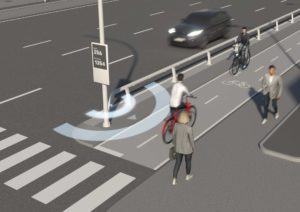
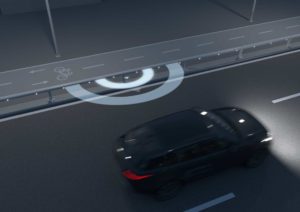
It is a system fully aligned with the new trends in infrastructure management: security, sustainability and connectivity.
- It guarantees safety because it has been tested on a real scale as certified by the CE marking.
- It promotes sustainable mobility by making the new infrastructures in cities safer and friendlier.
- It is connectable because it integrates PLUG&META® technology, which not only waits for the accident to happen, but also identifies risk situations, and acts by alerting road users through signalling, minimizing the probability that these accidents will happen. Up to 10 functional scenarios have been developed, for example, accident warning, pedestrian presence, excessive speed, traffic jams, or bad visibility warning, among others.
It is a totally innovative parapet because, as can be seen, in addition to containing it in the event of an accident, it prevents these from happening, and also collects data and informs the municipal authority of all those events that are desired, from quality data of air, counting or multiple statistics of events detected by the sensors incorporated in the parapet.
The system is modular, in such a way that SMART technology can be incorporated only in that section where there really is a special need, and the rest can be a traditional containment system that is 100% safe before leaving the track.
And all of this can be managed remotely thanks to the management platform accessible from any device.
In this way, a traditional containment system has evolved into a new traffic management and urban mobility and information service for the city.
The Metaurban® SMART parapet represents a breakthrough in the urban equipment sector, prompting the imagination of how the IoT can transform static elements into active digital members of the smart city ecosystem.
Our goal is to improve people's quality of life, focusing our efforts on offering a range of technologically advanced security and protection solutions. If you want to know a little more about this technology, visit our new microsite.
International Noise Awareness Day
Today is International Noise Awareness Day, a day to contribute in making our society understand the importance of reducing noise for our health and the environment.
Noise is usually defined as «Inarticulate sound, generally unpleasant». Today we live with noise everywhere due to the noise pollution produced, among others, by vehicles. The noise pollution to which we are exposed in our day to day life can cause serious consequences such as hearing loss, sleep disorders or cardiovascular diseases. Cities are taking more and more measures against these annoying sound, however, there is much work ahead, and other facilities such as airports, sports stadiums or auditoriums also need solutions to isolate noise
To reduce noise in urban spaces, we have a wide range of products that will combine with each space according to its style. Acoustic screens are an efficient and aesthetic solution that can be used in any of the cases.
Metagreen acoustic screens
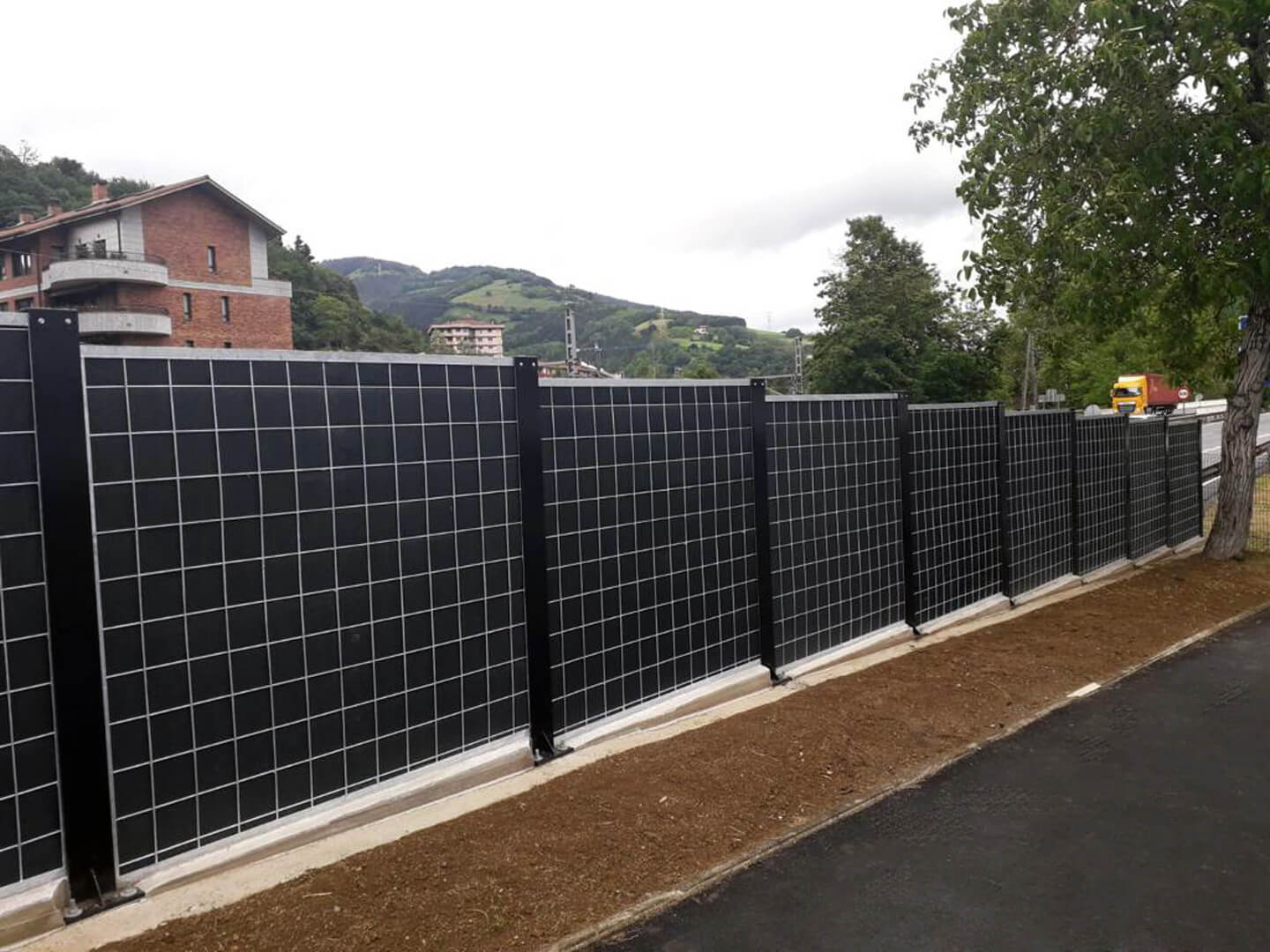
These screens are our most sustainable acoustic screens and not only they perform their job against noise, but they also contribute to sustainability thanks to their built-in vegetation and the use of recyclable materials in their manufacture. Vertical Garden Concept.
These are screens made up of an interior of rock wool as the main material to absorb external noise and an exterior of micro-perforated plastic mesh thanks to which vertical vegetation will grow.
These screens offer an ecological and natural appearance, perfect to be installed in urbanizations and private areas where they will give the appearance of a vertical garden. Its galvanized treatment offers a long durability of these screens that insulate and absorb noise magnificently.
Methacrylate acoustic screens
Acoustic methacrylate acoustic screens are ideal for not losing light and ensure a visual sensation of spaciousness. It is an insulating panel that consists of a polymethacrylate sheet in a structure made up of synthetic rubber gaskets.
The methacrylate panel configuration achieves maximum insulation. It integrates with the landscape thanks to its transparency and/or colors. These screens can be combined in the personalized model with other materials, achieving a product that completely adapts to the aesthetics of your city.
Metawood acoustic screens
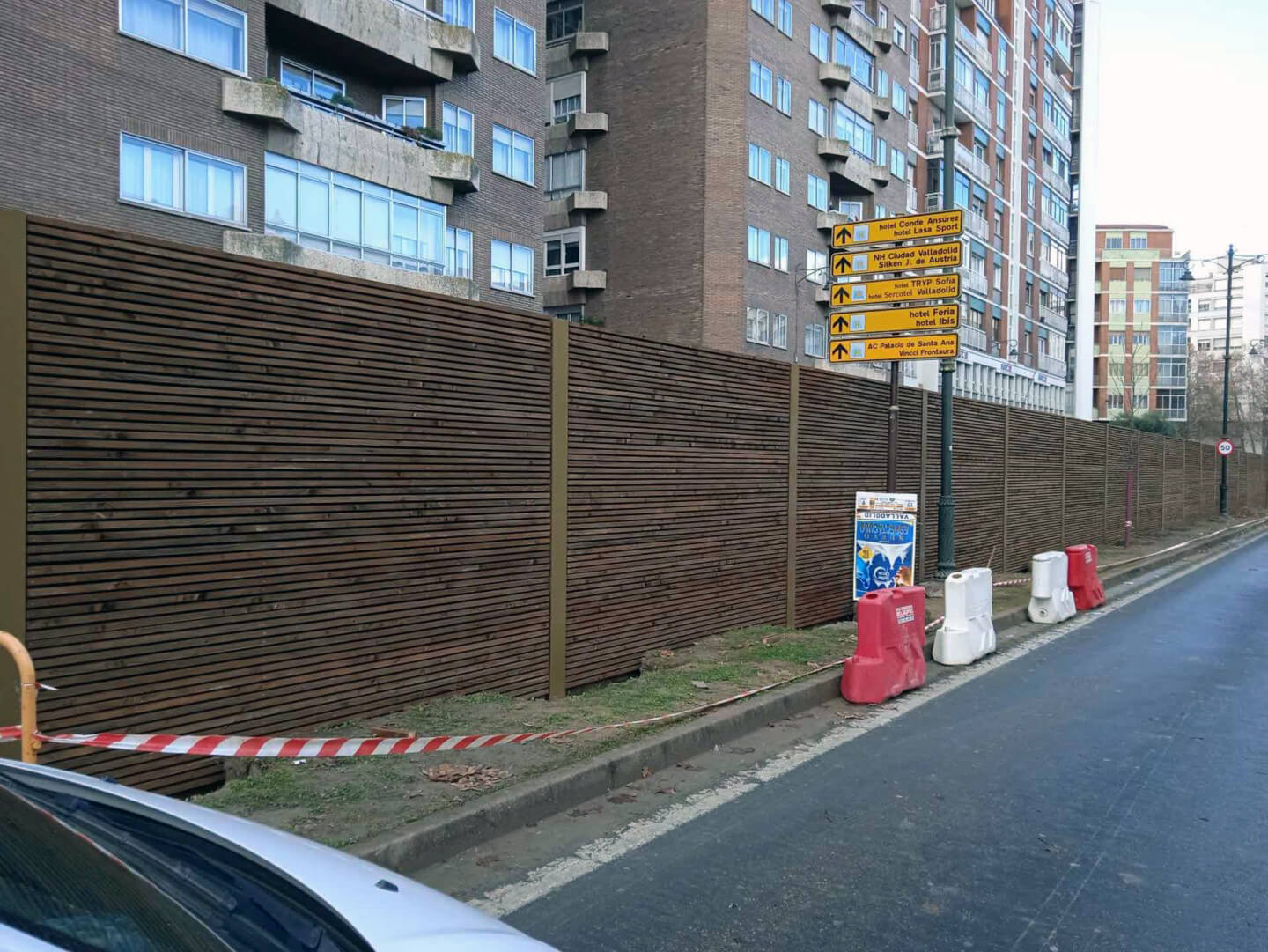
Wood also offers a touch of nature like Metagreen screens, but they can also be combined between wood vertically and horizontally to achieve different aesthetic effects.
Metawood screens have rock wool to isolate sound as well as a black protective veil that protects the panels from erosion and moisture.
Wood acoustic screens provide excellent insulation and maximum absorption. Its wooden aesthetic integrates perfectly with the landscape and the treatments they require are respectful of the environment.
Concrete acoustic screens
It is made up of a double layer of reinforced concrete structure and sound-absorbing porous concrete. These concrete acoustic panels can be the color of the concrete or painted smooth or with decoration.
It has good acoustic absorption. Isolates sound excellently. It is a very durable structure with low environmental impact, recyclable and without waste.
Customized acoustic screens
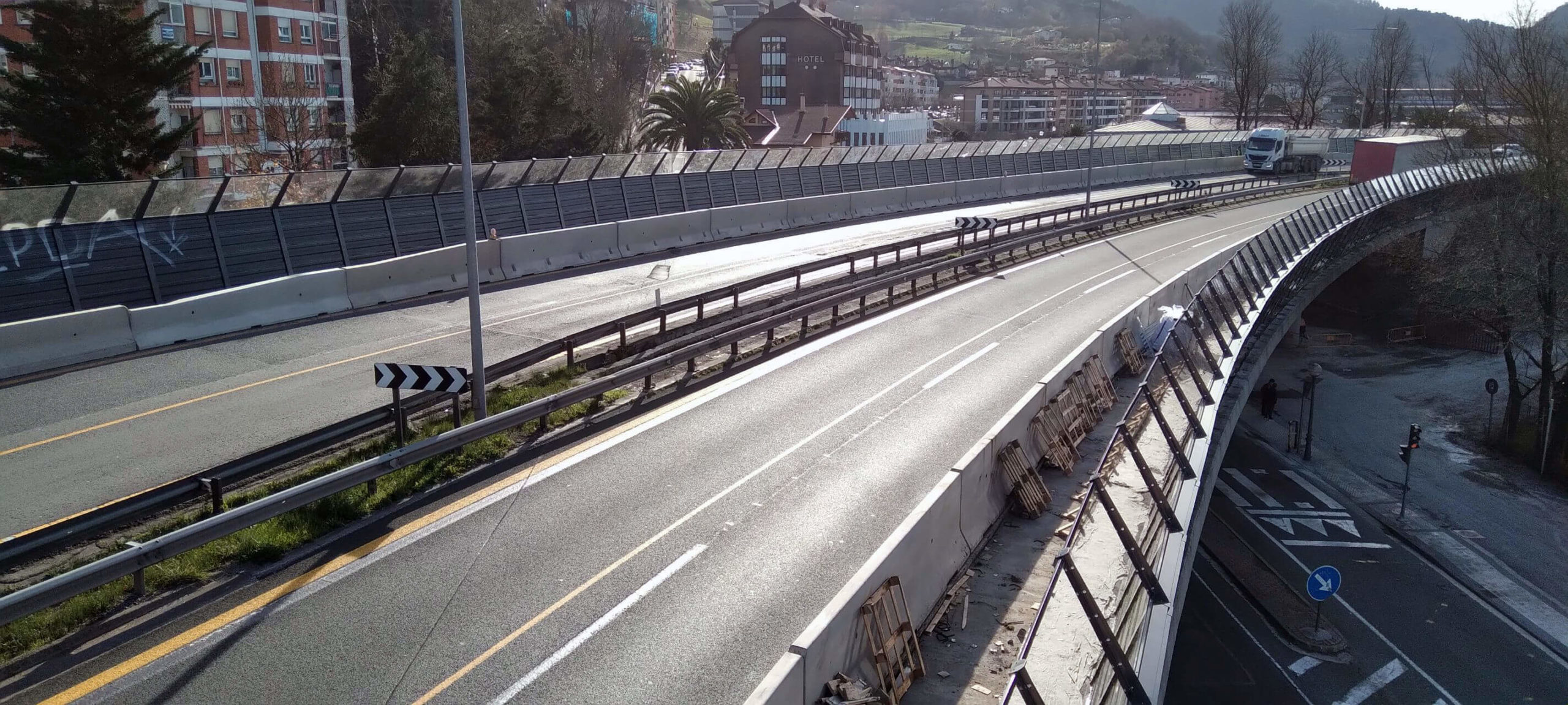
We can also create personalized noise barriers by combining different panel models, being able to design acoustic screens completely to the client's taste and adapted to the needs of each space.
It must be taken into account that the product that really performs the absorbent function is the rock wool housed inside, so the exterior can be designed to fit aesthetically with the space without affecting its properties.
These solutions that we describe for urban areas are applicable to isolate traffic noise on highways, where the installation of steel or aluminum acoustic screens is more common.
Steel or aluminum acoustic screens
Both the steel and aluminum acoustic screens are made up of a noise-absorbing layer, an inner layer of rock wool that isolates this noise, and the reflective layer so that the remaining noise does not pass through, but bounces back. Finally, to guarantee this acoustic performance, these panels are closed with polypropylene side covers.
They are a fantastic option for their insulation and absorption capabilities. In addition, they integrate with the environment thanks to their various designs and available combinations. Being a modular structure they are light and easy to install. They are also resistant to wind loads and rail traffic overpressure, a performance accredited in laboratory tests.
Acoustic screens can be temporary or fixed and the installation varies according to type. Among all the solutions that we offer in Metalesa, a previous acoustic study will always be assessed to guarantee the best solution against noise that adapts to the needs of the space. You can compare our screens in the product comparator or contact us, we will be happy to help you.
METAURBAN®, the containment system for today's cities
At Metalesa we firmly believe that the key lever to our growth as a family SME is Innovation, and that is the reason why we invest so much in R&D, with our own team of engineers and designers who continuously observe the environment and incorporate the best of other technologically cutting-edge sectors to our product catalogue. Hence, we can offer no only innovative road safety solutions, but also effective and competitive.
Today we want to focus on the METAURBAN®, a vehicle restraint system specially designed for installation on urban or peri-urban roads, and with CE marking.
Our latest flagship product, designed to promote safe sustainable mobility, is already being installed in numerous urban environments and cities due to its great proved performance and elegant aesthetics.
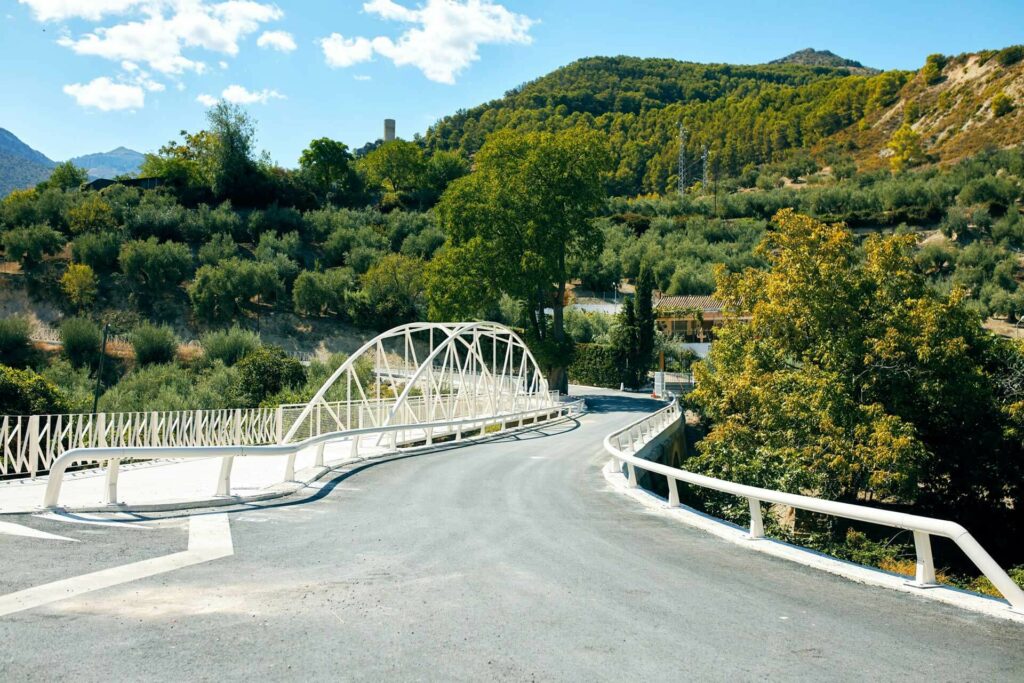
When we think of road safety, what first comes to our minds is cars at high speeds, but statistics go in a very different direction, and that is that urban and local roads are the areas with worse accident and mortality rates.
On the other hand, the massive proliferation of personal mobility vehicles, and the intensive deployment of bike lanes, represent a notable increase in risk and danger, especially for the most vulnerable groups such as children, old people and drivers of bicycles and electric scooters themselves.

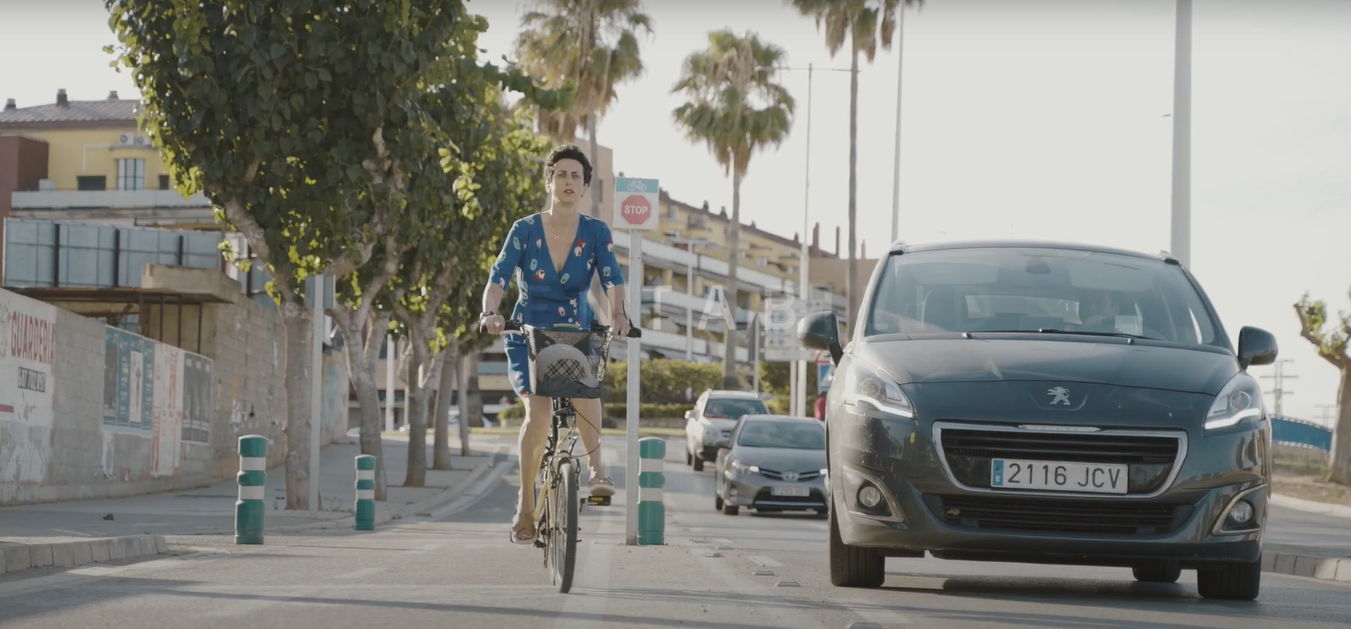
Discover all its advantages
METAURBAN® metal parapet has been designed and tested to provide excellent security features in today's urban environments.
To guarantee its effectiveness in the event of an accident, the METAURBAN® containment system has been rigorously tested through a full-scale crash test, according to the European Standard EN 1317, having satisfactorily passed all the acceptance criteria for the containment level N1, the most suitable for urban environments.
The METAURBAN® metal parapet includes features that make it an essential product for the safety of the most vulnerable users in urban environments, such as pedestrians or cyclists.
- In addition, it can be perfectly adapted to curved paths.
- It features an easy assembly and disassembly process if components are damaged by impact; there is no need for weld joints or cuts.
- Regarding its installation, the parapet has been tested by means of a chemical-fuse anchoring system that protects the concrete band against an impact, allowing its easy replacement in the event of an accident.
- Great aesthetics, helps that today's cities maintain their charm
- The techniques used to guarantee its protection against corrosion like hot-dip galvanizing according to the EN 1461 standard, and thermo-lacquering in the different colors of the RAL chart respectively.
- Possibility of incorporating the motorcycle protection system (SPM) into the structure.
In summary, with the installation of the METAURBAN® containment system, urban and metropolitan roads with speed limits of 20.30, 50 and 80 km/h, become areas in which travelling is much safer, which will be key for users to lose their fear and adopt new urban sustainable mobility models.
Metaurban® has already reached our cities. Some projects
Metaurban is already a reality in many Spanish cities. Here are some projects that already have our METAURBAN® metal parapet.
Road reconditioning in Bedmar (Jaén)

Pass over A-7 in Estepona (Málaga)
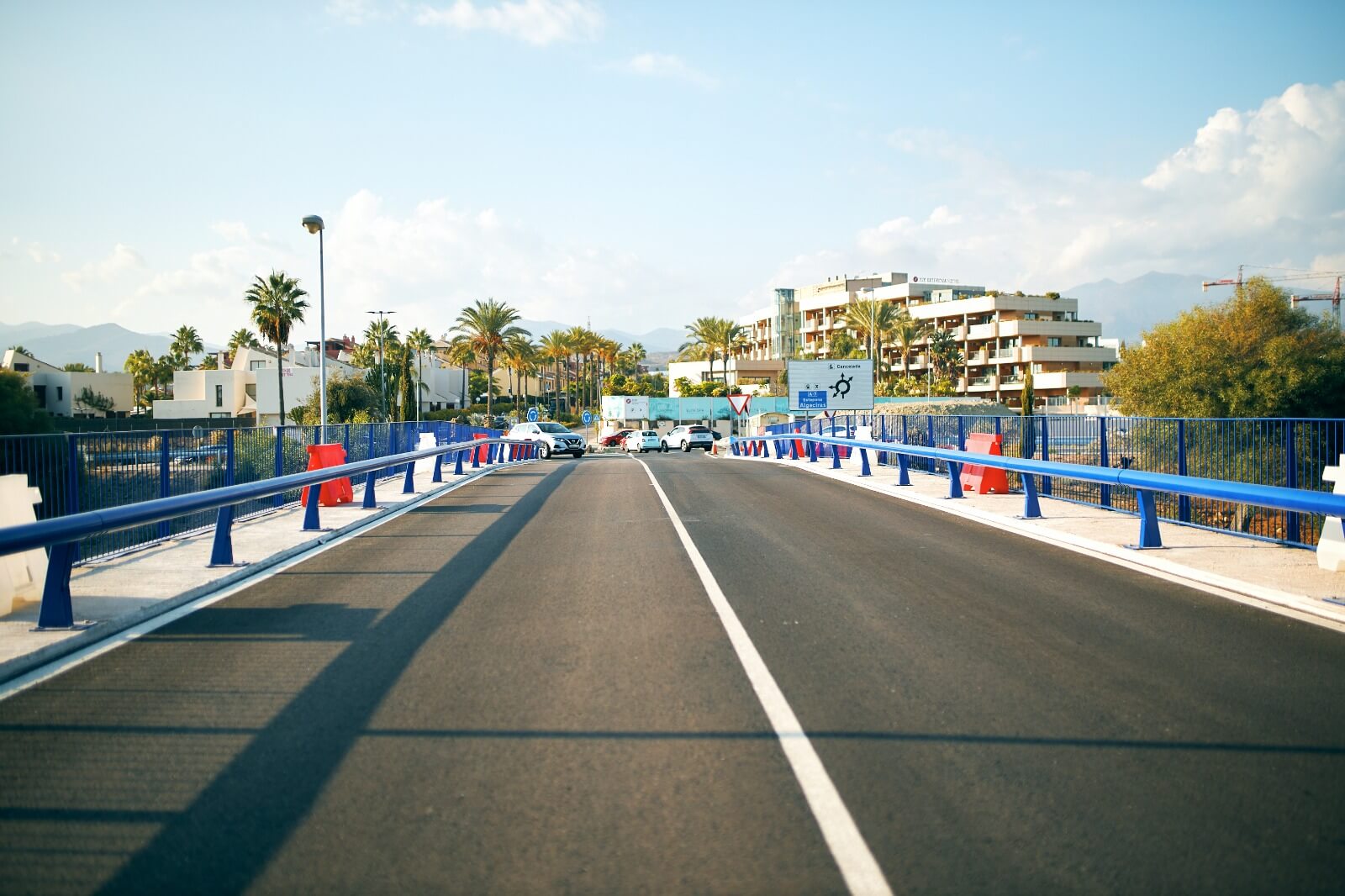
Zamora
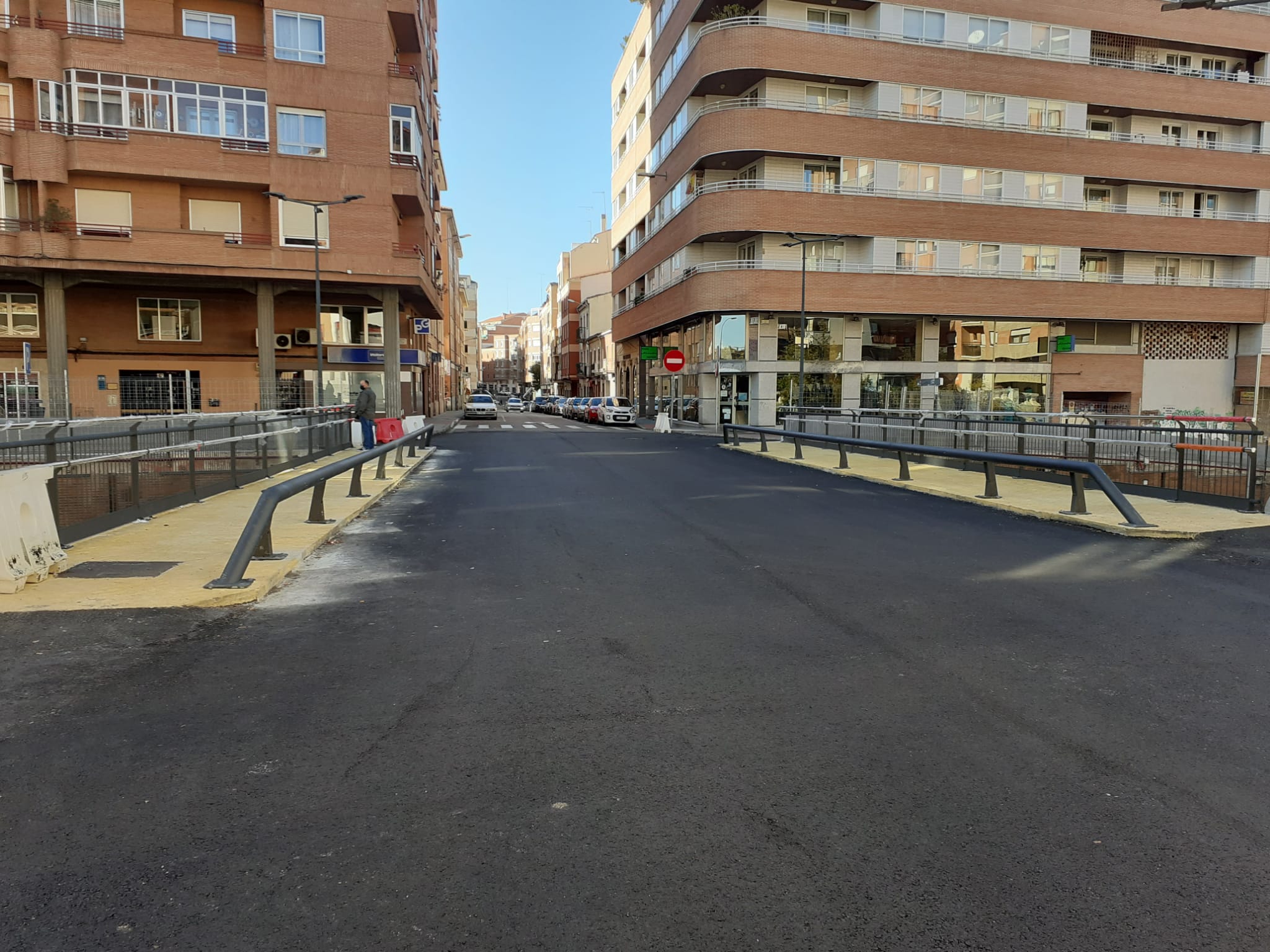
We are proud to think that, thanks to the installation of the METAURBAN® containment system, these urban roads are now much safer, and that with their installation we are increasingly closer to our goal: the protection of people.
If you are an installer, engineer, architect or an individual, and you need guidance about this product, do not hesitate to contact us. Together we will create the safe cities we all deserve to live in.
The loudest roads and railway areas of the Valencian Community
It is no secret that both roads and railways are sources of excessive noise, causing annoyance both to the population and to the conservation of the environment. Specifically in the Valencian Community, it is estimated that approximately 183,000 inhabitants are daily exposed to noise that comes from the main infrastructures, which is a quite alarming fact considering the negative consequences of noise pollution.
The CV-35, one of the roads with the highest levels of noise pollution
The acoustic studies carried out in the main roads of the Valencian Community have concluded that the CV-35 is one of the most affected road, since around 10,000 people support up to 75 decibels at peak times of the day.
Another section with a high noise concentration is the one between Vilamarxant and Benisanó on the CV-50. In this area there are several schools and institutes that must withstand noises of up to 70 decibels.
On the other hand, although the railway network generates less acoustic nuisance, we must also focus on the acoustic problems that derive from the noise of the trains.
According to a European Environment Agency (EEA) report in 2010, railway noise affected over 12 million inhabitants of the European Union every day, figures that may well have increased since that time.
Rail noise in Europe is especially concentrated in Western European countries, among which is Spain. The main sources of noise pollution in railways are engine, rolling and aerodynamic noise, while the most annoying ones are produced by freight trains. We must not forget that passenger stations, places for receiving goods (dry ports), train maintenance activities and other facilities also generate noise in their daily operation. Given this, it may seem that noise pollution caused by the railway and its facilities is almost impossible to eliminate, but the truth is that it is easier to mitigate.

Consequences of noise pollution for our health
As we have seen, there are high figures that confirm that many people are victims of the problems derived by noise pollution from roads and railway areas in the Valencian Community. What are the harmful consequences of excess noise for health?
- Hearing problems: it is the most common and one of the most worrisome. Keep in mind that any sound above 85 decibels can damage hearing, and on roads and railways, this limit is often far exceeded. Someone who lives in this type of area is continuously exposed to a very high noise level, and consequently can develop hearing loss.
- Cardiovascular problems: Constant exposure to high noise levels can increase blood pressure, increase heart rate and increase stress by releasing the hormone cortisol ... All of this can lead to an imbalance of vital body functions.
- Sleep problems: If the home is near highway areas, the noise from freight trucks is very likely to cause sleep disturbances. As we mentioned in the previous point, cardiovascular problems are a long-term effect of this exposure to excess noise. In the short term, the most notable are fatigue, impaired memory and creative abilities, and difficulty concentrating.
- Digestive problems: Although to a lesser extent, there are studies that have shown that excess noise leads to a decrease in peristalsis, that is, muscle contractions thanks to which the food eaten moves through the digestive system. As a consequence, problems such as gastritis, ulcers, heartburn, loss of appetite, diarrhea or constipation may be more frequent.

How can we solve this problem?
The expansion of urban centers towards industrial areas has meant that many living areas are located very close to road and railway infrastructures, and this requires effective solutions that eliminate excess of noise.
Acoustic Screens
As experts in acoustic solutions, from Metalesa we can certify that acoustic screens are an effective solution to reduce or eliminate this noise. But first, from Metalesa we get in charge of conducting acoustic studies, which are used to extract noise maps that measure noise pollution in a specific area, and based on the results, we take care of adopting the necessary measures through the installation of acoustic screens.
Types of acoustic screens for roads and railway areas
Steel or aluminium metal acoustic screen
These types of acoustic screens are made up of galvanized steel or aluminum panels, which are vertically superimposed between HEA / HEB profiles until the desired height is achieved. By installing metal acoustic screens on roads or railway areas close to human environments, we obtain maximum insulation and absorption, which is a very effective solution to counteract the negative effects of noise.
In addition, other advantages of the metallic acoustic screen are its ease of installation, its long durability thanks to the quality of its components, and its resistance to loads such as the action of the wind or the overpressures produced by rail traffic.
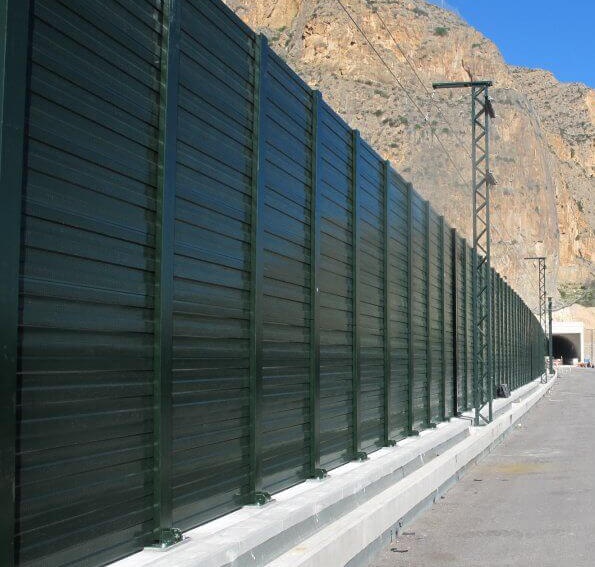
Metallic acoustic screen with mesh or vegetable
This type of plant acoustic noise screens also achieve great noise absorption and acoustic insulation in road and railway areas. Inside the panels that form it, rock wool is placed together with a green plastic mesh that facilitates the growth of vegetation.
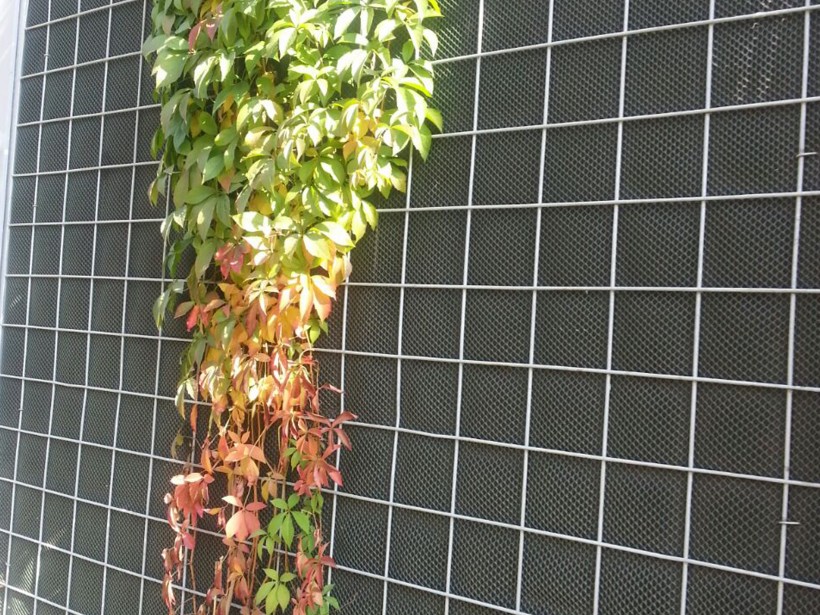
Methacrylate acoustic screen
Las características acústicas de las pantallas acústicas de metacrilato o vidrio también son muy eficientes. Están formadas por paneles de metacrilato cuyas propiedades de aislamiento han sido evaluadas de acuerdo a la norma EN 1793-2:1998, obteniendo un elevado índice de aislamiento.
The acoustic characteristics of methacrylate or glass acoustic screens are also very efficient. They are made of methacrylate panels whose insulation properties have been evaluated according to the EN 1793-2: 1998 standard, obtaining a high insulation index.
In addition, it is an easy-to-install acoustic screen, which allows landscape integration, and has a long durability thanks to the quality of its components. For all this, they are ideal to be installed in noisy areas.
Methacrylate can be transparent or have a certain color. Likewise, it is possible to install vinyl solutions on the methacrylate to prevent damage to the birds in the environment.
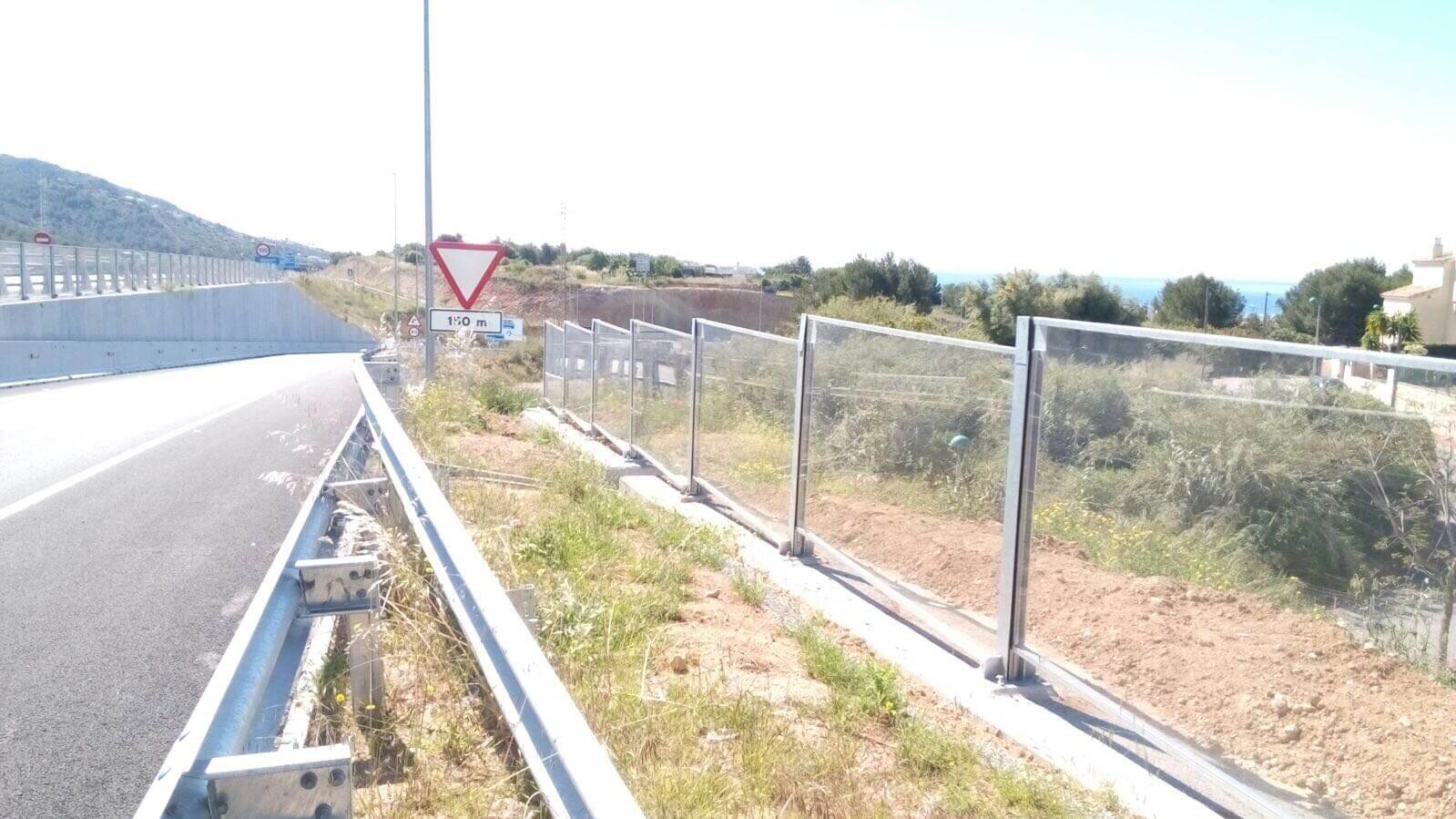
Wooden Acoustic Screen
This wooden anti-noise screen performs a double acoustic and aesthetic function and is made up of the following elements:
- Absorbent and reflective face: treated Scots pine wood slats.
- Acoustic insulation: rock wool with black protective veil.
- Supporting structure: made up of HEA / HEB-type uprights with hot-dip galvanized welded base plate and painted with polyester powder paint.
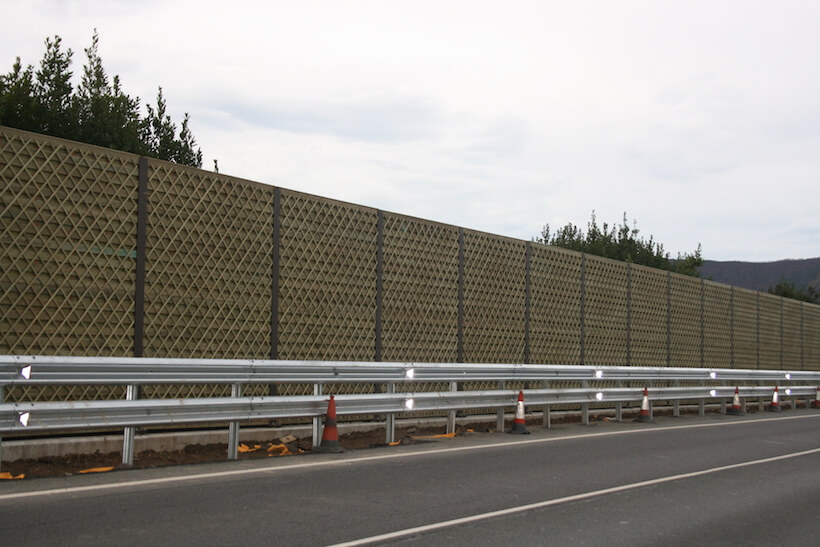
Concrete acoustic screen
Concrete acoustic screens are also a very effective option for noise abatement in railway areas.
Among its main characteristics we find its great stability, and its resistance over time, which is why its maintenance is scarce. This consistency is achieved thanks to its materials: cement, sand, water and gravel or crushed stone, giving rise to a highly rigid structure.
The concrete is supported by metal pillars, which also receive a specific treatment to withstand the passage of time. The anchoring of the steel profiles is carried out on the concrete through bolts of variable diameter and length, depending on the client's needs.
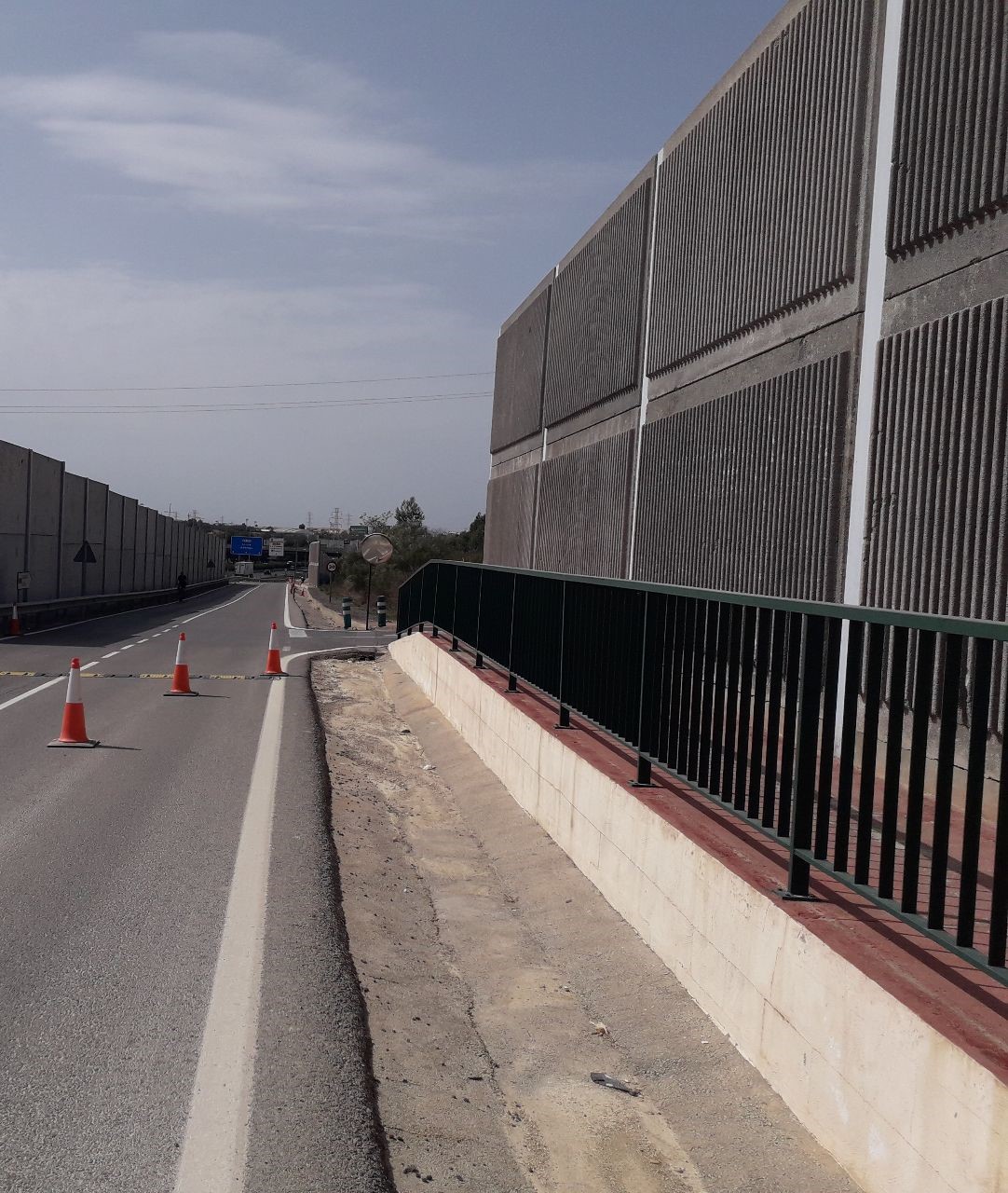
Like the rest of acoustic screens, it also allows maximum noise absorption and excellent landscape integration.Noise pollution is a very serious problem, but ‘invisible’ and fortunately more and more society is giving it the importance it requires to implement effective solutions. Undoubtedly, the installation of acoustic screens to absorb noise on roads and railways is the best option to prevent harmful consequences on the health of people who live near these areas. At Metalesa, we want to be part of the solution with our acoustic screens. If you need our services, contact us by calling +34 96 088 99 44 or send us an email to metalesa@metalesa.com.
Awards ceremony for the 1st METALESA Awards for the best Final Degree Project in the UPV’s School of Civil Engineering.
During Engineering Week of the UPV’s School of Civil Engineering (SICMA 2018), METALESA held an event on Wednesday 28 February to announce the winners of the 1st METALESA Awards for the best Final Degree Project.
This initiative is part of the Metalesa Talent Platform, which arose from our company’s commitment to promoting endeavour and talent amongst new generations of engineers.
The jury, composed of several of the School’s lecturers and members of METALESA, valued the excellence of two works that stood out for the originality of their approach and the rigour of their execution. The first prize went to Adrián Santes Genovés for his “Study of solutions for the location and design of a space to practice longboard in the province of Castellón” and he was awarded €1,200. Second prize went to Manuel Buitrago Moreno who was awarded €600 for his analysis of “Maritime terminals and logistics chains for liquefied natural gas (LNG). Assessment of future needs in Spain”. Both the School and the company appreciated the enthusiasm of all participants and the quality of the work presented.
The event was attended by Mr Antonio Sánchez, a Civil Engineer, and Director of the company ESMOVibilidad, who spoke about his vision and experience on a topic that is ever more at the forefront in big infrastructure construction projects in our country, “Road safety audits in preliminary and project phases. Experiences of implementation in Spain”.
METALESA hope these awards will run annually with new editions that continue to unearth students’ talent and offer them a real experience of the civil works sector.
[carousel_slide id='5074']
METALESA sponsors the 40th Volta a Peu in Carcaixent
As part of the corporate culture and social responsibility, METALESA again sponsors the XL Volta a Peu in Carcaixent, encouraging sporting values and health in our society. The event celebrates its 40th anniversary this year and it is expected that a large number of runners from all over the region will take part. The 10km race along an urban circuit takes place on Saturday 29th September at 10:30am. The children's race will take place one hour beforehand with the aim of encouraging the little ones to get into doing sports.
Successful participation in the 40th Volta a Peu in Carcaixent
On Sunday 29th September the 40th Volta a Peu took place in Carcaixent, a 10-kilometre fun run in which almost 700 participants from across the region packed the urban circuit set out especially for the occasion, demonstrating that running is in fashion in the Valencian Community. As part of its social responsibility, METALESA sponsored the event for the second consecutive year and made a donation of €10 for each registered runner, which was given to the Food Bank in Carcaixent.

